parking brake CHEVROLET CAVALIER 1993 1.G Owners Manual
[x] Cancel search | Manufacturer: CHEVROLET, Model Year: 1993, Model line: CAVALIER, Model: CHEVROLET CAVALIER 1993 1.GPages: 308, PDF Size: 15.62 MB
Page 49 of 308
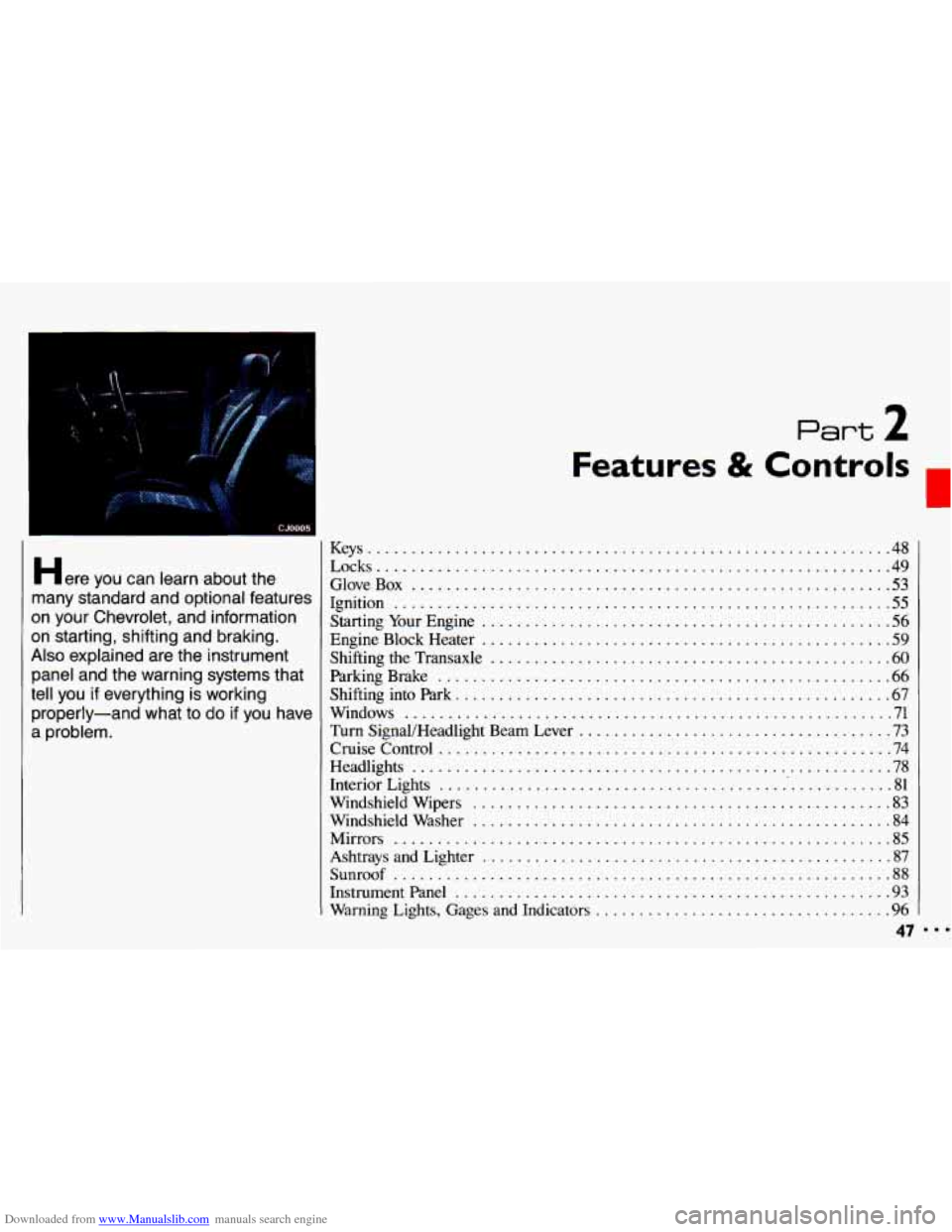
Downloaded from www.Manualslib.com manuals search engine ..
.; . I
Here you can learn about the
many standard and optional features
on your Chevrolet. and information
on starting. shifting and braking
.
Also explained are the instrument
panel and the warning systems that
tell you
if everything is working
properly-and what to
do if you have
a problem
.
Part 2
Features & Controls
Keys ............................................................ 48
Locks ........................................................... 49
GloveBox ....................................................... 53
Ignition ......................................................... 55
StartingYourEngine ............................................... 56
Engine Block Heater ............................................... 59
Shifting the Transaxle
.............................................. 60
ParkingBrake .................................................... 66
ShiftingintoPark .................................................. 67
Windows
........................................................ 71
Turn SignaVHeadlight Beam Lever
................................... -73
Cruisecontrol
.................................................... 74
Headlights
....................................................... 78
Interior Lights
.................................................... 81
Windshield Wipers
................................................ 83
Windshield Washer
................................................ 84
Mirrors
......................................................... 85
Ashtrays and Lighter
............................................... 87
Sunroof ......................................................... 88
Instrumentpanel .................................................. 93
Warning Lights, Gages and Indicators
.................................. 96
47
c
...
Page 54 of 308
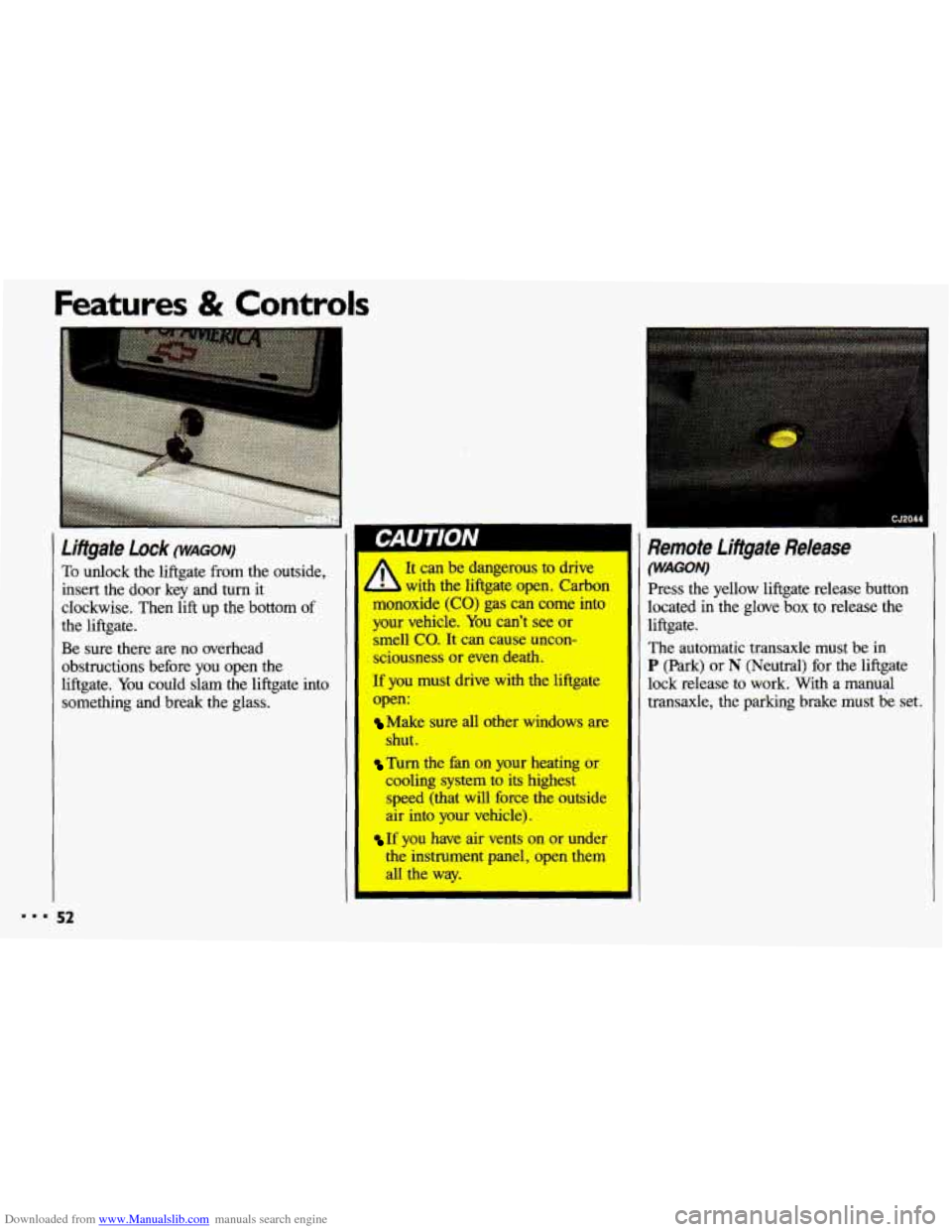
Downloaded from www.Manualslib.com manuals search engine Features & Controls
To &dock the liftgate from the outside,
insert the door key and turn it
clockwise. Then
lift up the bottom of
the liftgate.
Be sure there are no overhead
obstructions before you open the
liftgate. You could slam the liftgate into
something and break the glass.
I CJ2044
Remote Lifigate Release
(WAGON) It can be dangerous to drive
L with the liftgate open. Carbon
monoxide
(CO) gas can come into
your vehicle.
You can’t see or I smell co. It can cause uncon-
sciousness or even death.
If you must drive with the liftgate lock release to work. With a manual
open: transaxle, the parking brake must be set.
I
The automatic transaxle must be in
P (Park) or N (Neutral) for the liftgate
Make sure all other windows are
shut.
Turn the fan on your heating or
cooling system to its highest
speed (that will force the outside
air into your vehicle).
If you have air vents on or under
the instrument panel, open them
all the way. Press the
yellow liftgate release button
located in the glove box to release the
liftgate.
Page 62 of 308
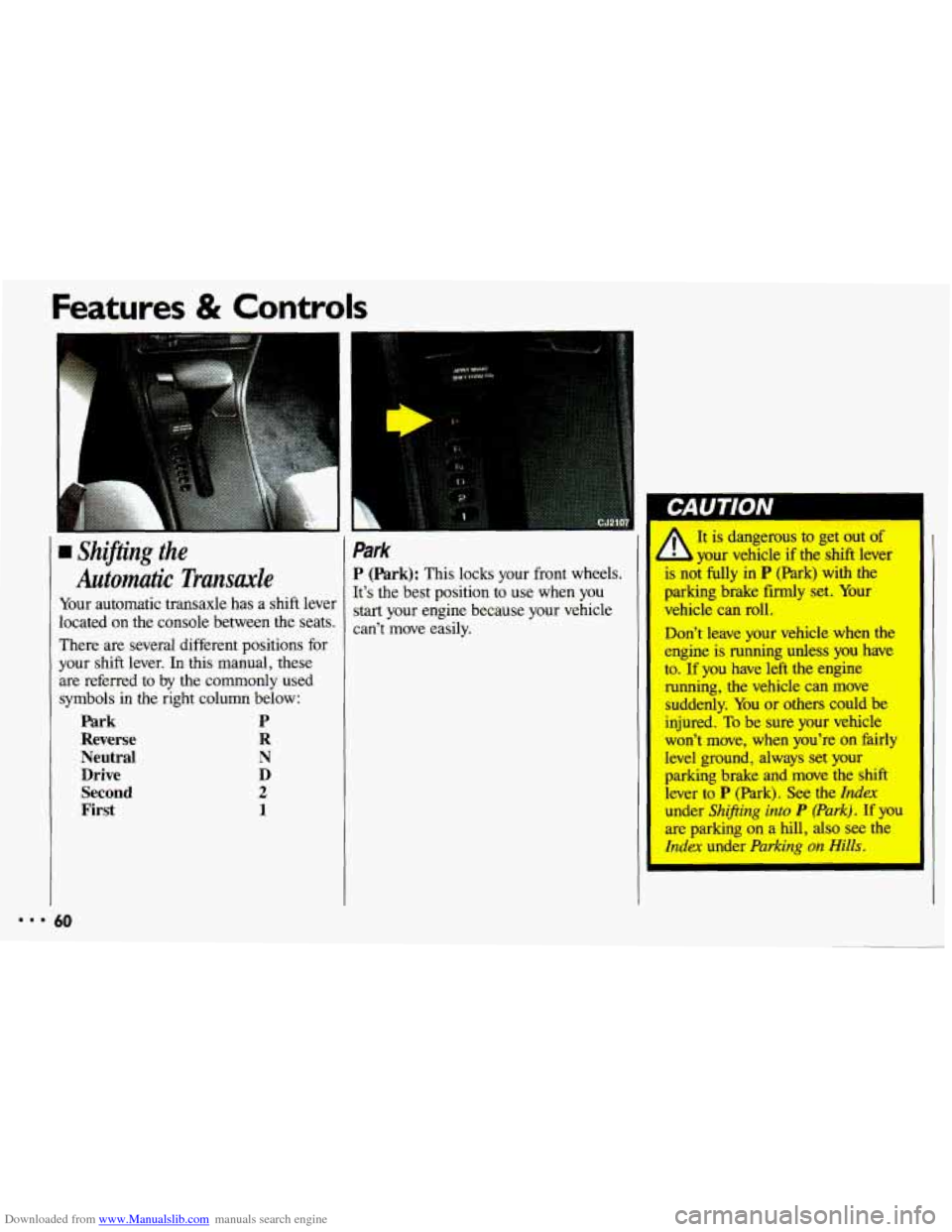
Downloaded from www.Manualslib.com manuals search engine Features & Controls
rn Shifting the
Automatic Transaxle
Your automatic transaxle has a shift lever
located
on the console between the seats.
There are several different positions for
your shift lever. In this manual, these
are referred to by the commonly used
symbols in
the right column below:
Park P
Reverse R
Neutral
N
Drive D
Second
2
First 1
Park
P (Park): This locks your front wheels.
It’s the best position to use when you
start your engine because your vehicle
can’t move easily.
I It is dangerous to get out of
your vehicle if the shift lever
is noi fully in
P (Park) with the
parking brake firmly set. Your
vehicle can roll.
Don’t leave your vehicle when the
engine is running unless
you have
to.
If you have left the engine
running, the vehicle can move
suddenly. You or others could be
injured.
To be sure your vehicle
won’t move, when you’re on fairly
level ground, always set your
parking brake and move the shift
lever to
P (Park). See the Index
under Shifting into P (Park). If you
are parking on a hill, also see the
Index under Parking on Hills.
Page 67 of 308
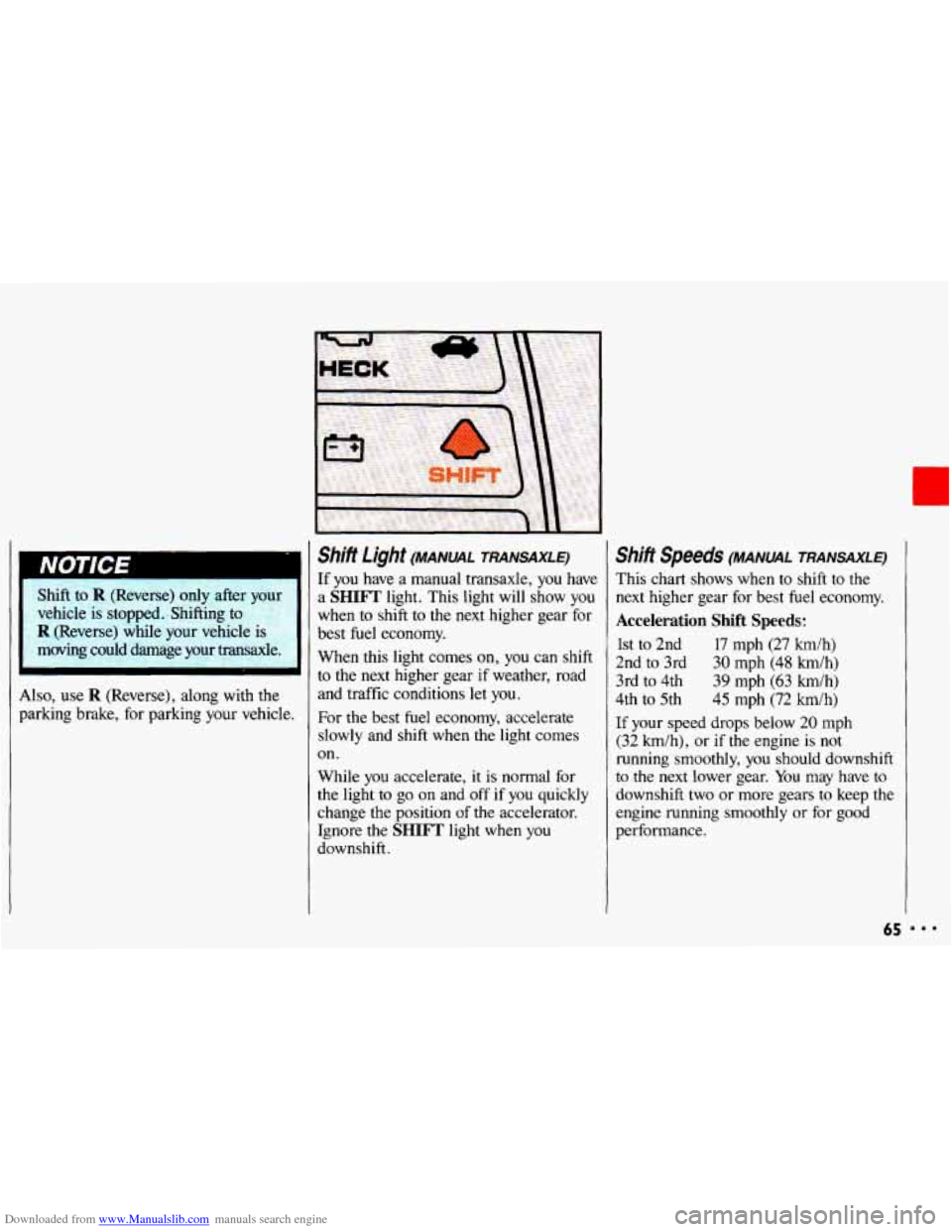
Downloaded from www.Manualslib.com manuals search engine r
Shift to R (Reverse) only afte
vehicle is stopped. Shifting to
R (Reverse) while your vehicle is
moving could damage your transaxle.
Also, use
R (Reverse), along with the
parking brake,
for parking your vehicle.
Shift Light (MANUAL TRANSAXLE)
If you have a manual transaxle, you have
a
SHIFT light. This light will show you
when to shift to the next higher gear for
best fuel economy.
When this light comes
on, you can shift
to the next higher gear if weather, road
and traffic conditions let you.
For
the best fuel economy, accelerate
slowly and shift when the light comes
on.
While you accelerate,
it is normal for
the light
to go on and off if you quickly
change the position
of the accelerator.
Ignore the
SHIFT light when you
downshift.
Shifi Speeds (MANUAL TRANSAXLE)
This chart shows when to shift to the
next higher gear for best fuel economy.
Acceleration Shift Speeds:
1st to 2nd 17 mph (27 km/h)
2nd to 3rd
30 mph (48 km/h)
3rd to 4th 39 mph
(63 h/h)
4th
to 5th 45 mph (72 h/h)
If your speed drops below 20 mph
(32 h/h), or if the engine is not
running smoothly,
you should downshift
to the
next lower gear. You may have to
downshift
two or more gears to keep the
engine running smoothly or
for good
performance.
65
Page 68 of 308
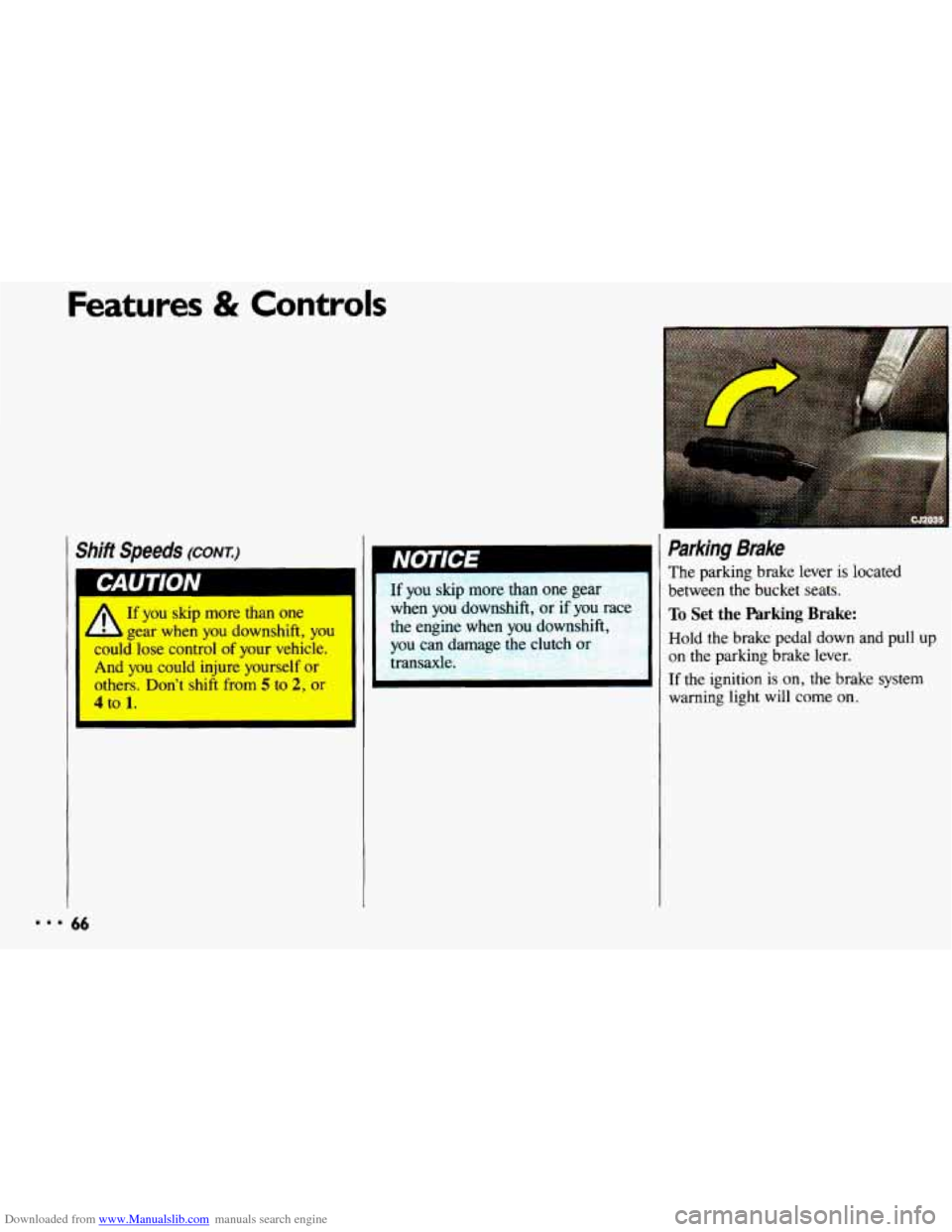
Downloaded from www.Manualslib.com manuals search engine Features & Controls
ShiiT Speeds (COPIT.)
If you skip more than one
4 1 gear when you downshift, you
could lose control of your vehicle.
And you could injure yourself
or
others. Don’t shift from 5 to 2, or
4 to 1.
I
I b
66
when you downshift, or if you
the engine when you downshift,
you
can damage the clutch or
transaxle.
i
Parking Brake
The parking brake lever is located
between
the bucket seats.
To Set the Parking Brake:
Hold the brake pedal down and pull up
on the parking brake lever.
If the ignition is on, the brake system
warning
light will come on.
Page 69 of 308
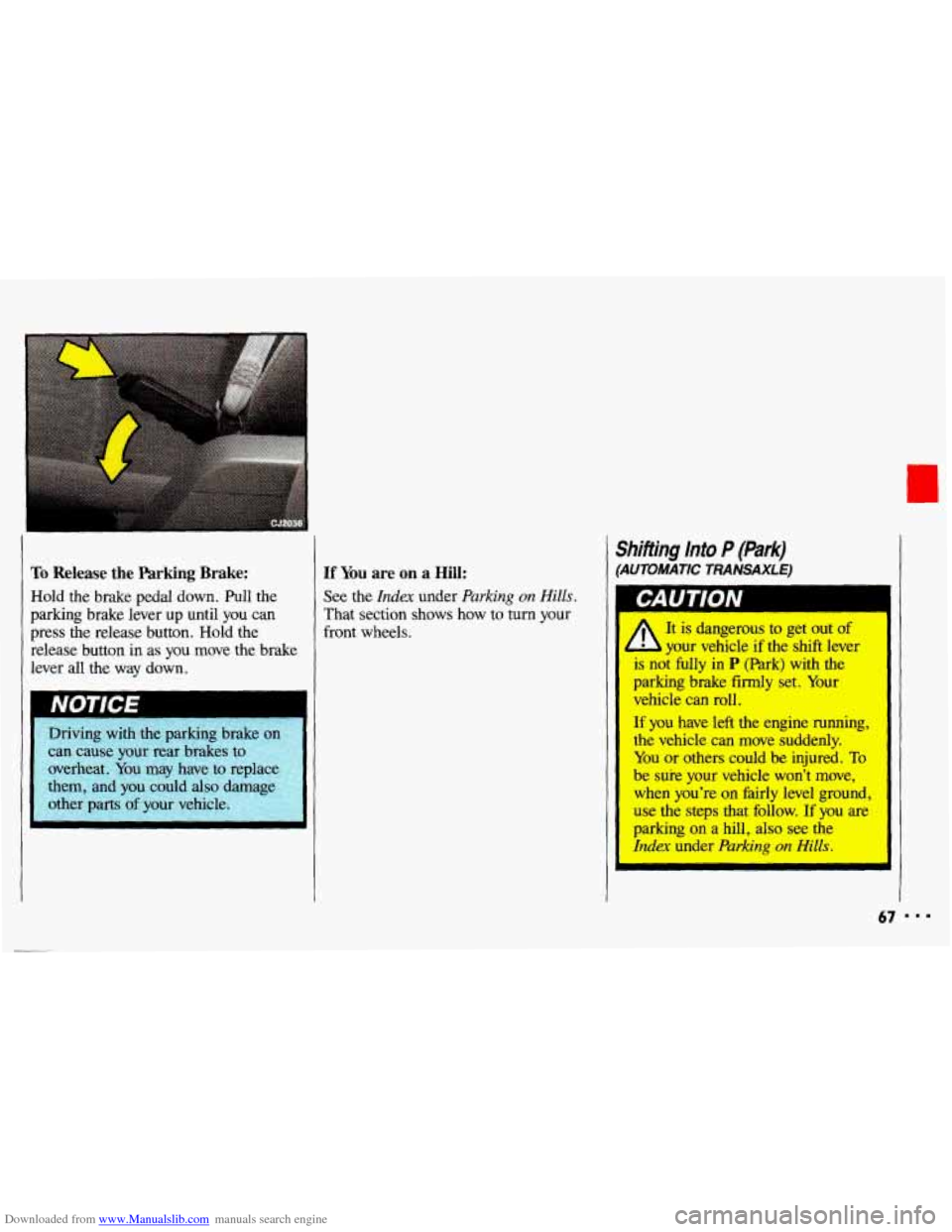
Downloaded from www.Manualslib.com manuals search engine To Release the Parking Brake:
Hold the brake pedal down. Pull the
parking brake lever up until you can
press the release button. Hold the
release button in as you move the brake
lever all the way down.
Driving with the parking brake on
I
can cause your rear brakes to
overheat.
You may have to replam
them, and
you could also dama
other parts
of your vehicle.
J
If You are on a Hill:
See the Index under Parking on Hills.
That section shows how to turn your
front wheels.
Shifting Into P (Park)
(AUTOMATIC TRANSAXLE)
A
It is dangerous to get out of
your vehicle if the shift lever
is not fully in
P (Park) with the
parking brake firmly set. Your
vehicle can roll.
If you have left the engine running,
the vehicle can move suddenly.
You or others could be injured. To
be sure your vehicle won’t move,
when you’re on fairly level ground,
use the steps that follow.
If you are
parking on a hill, also
see the
Index under Parking on Hills.
67
Page 70 of 308
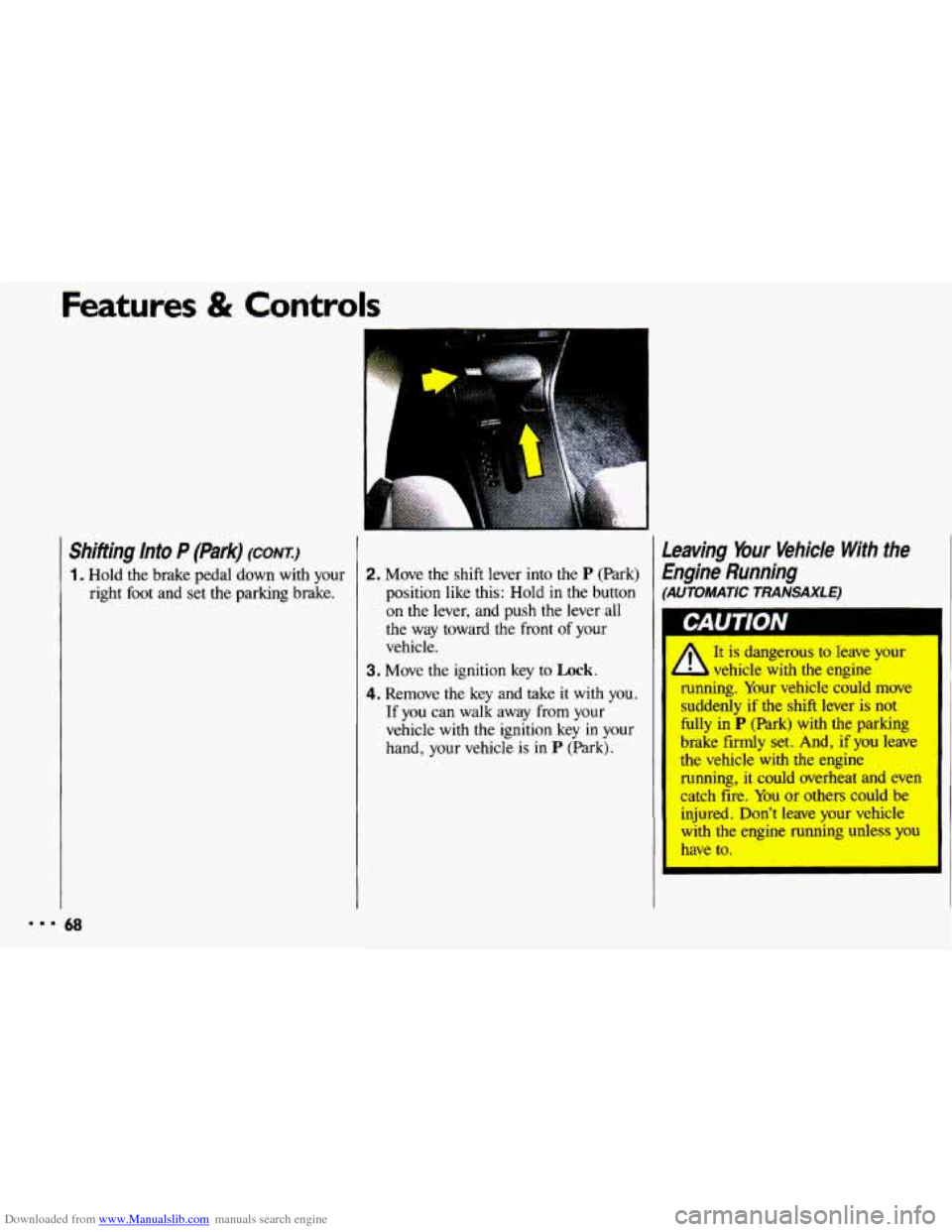
Downloaded from www.Manualslib.com manuals search engine Features & Controls
Shifting Into P (Park) (CONTI
1. Hold the brake pedal down with your right foot and set the parking brake.
A
2. Move the shift lever into the P (Park)
position like this: Hold in the button on the lever, and push the lever all
the way toward the front of your
vehicle.
3. Move the ignition key to Lock.
4. Remove the key and take it with you.
If you can walk away
from your
vehicle with the ignition key
in your
hand, your vehicle is in
P (Park).
Leaving Your Vehicle With the
Engine Running
(AUTOMATIC TRANSAXLE)
It is dangerous to leave your
running. Your vehicle could move
suddenly
if the shift lever is not
fully in
P (Park) with the parking
brake
firmly set. And, if you leave
the vehicle
with the engine
running, it could overheat and even
catch fire. You
or others could be
injured. Don't leave your vehicle
with the engine running unless you
have to.
I I L vehicle with the engine
Page 71 of 308
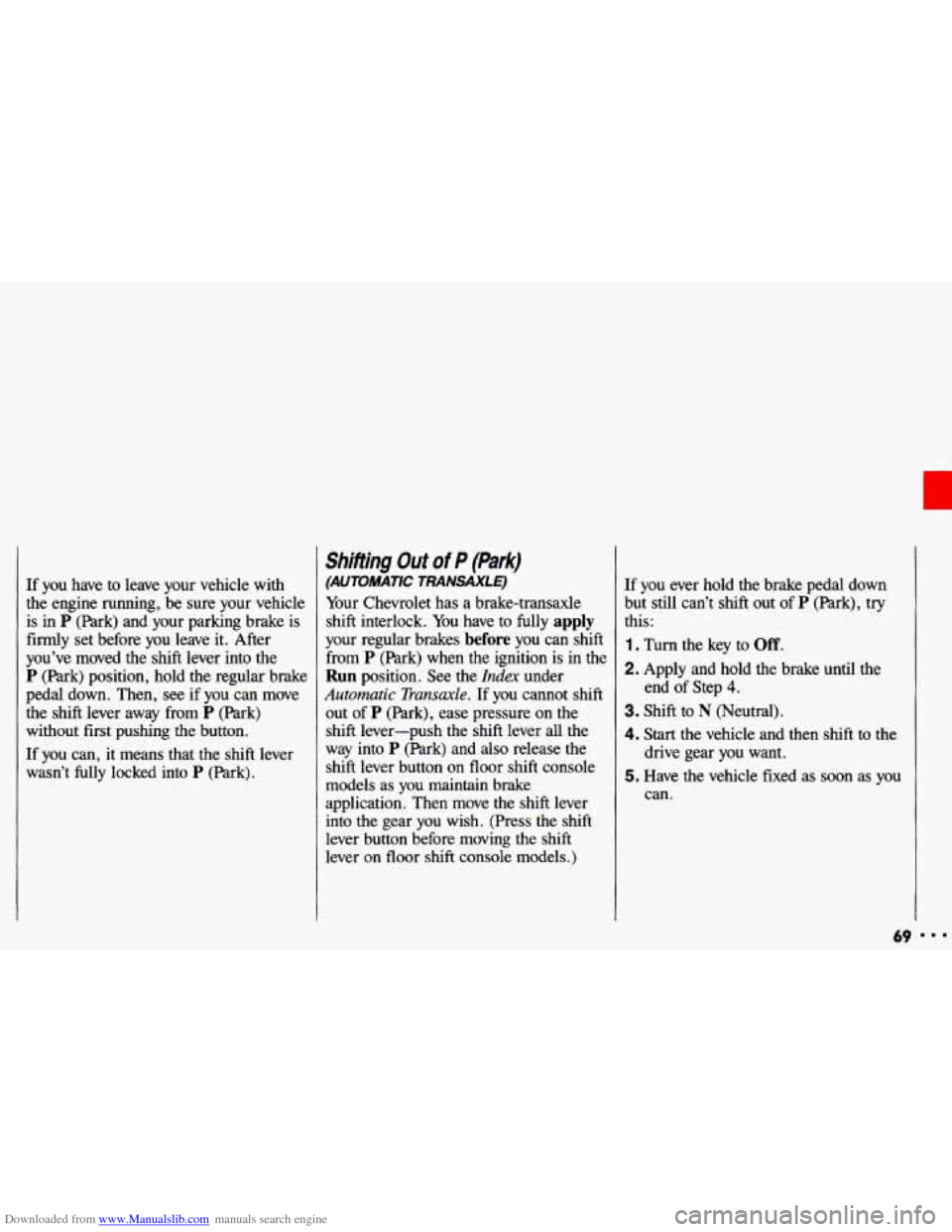
Downloaded from www.Manualslib.com manuals search engine If you have to leave your vehicle with
the engine running, be sure your vehicle is in
P (Park) and your parking brake is
firmly set before you leave it. After
you’ve moved the shift lever into the
P (Park) position, hold the regular brake
pedal down. Then, see if you can move
the shift lever away from
P (Park)
without first pushing the button.
If you can, it means that the shift lever
wasn’t fully locked into
P (Park).
Shifting Out of P (Park)
(AUTOMATIC TRANSAXLE)
Your Chevrolet has a brake-transaxle
shift interlock. You have to fully
apply
your regular brakes before you can shift
from
P (Park) when the ignition is in the
Run position. See the Index under
Automatic Transu.de. If you cannot shift
out
of P (Park), ease pressure on the
shift lever-push the shift lever all
the
way into P (Park) and also release the
shift lever button on floor shift console
models as you maintain brake
application. Then move the shift lever
into the gear
you wish. (Press the shift
lever button before moving the shift lever on floor shift console models.) If you ever hold the brake pedal
down
but still can’t shift out of
P (Park), try
this:
1. Turn the key to Off.
2. Apply and hold the brake until the
3. Shift to N (Neutral).
4. Start the vehicle and then shift to the
drive gear you want.
5. Have the vehicle fixed as soon as you
can. end
of Step 4.
69
Page 72 of 308
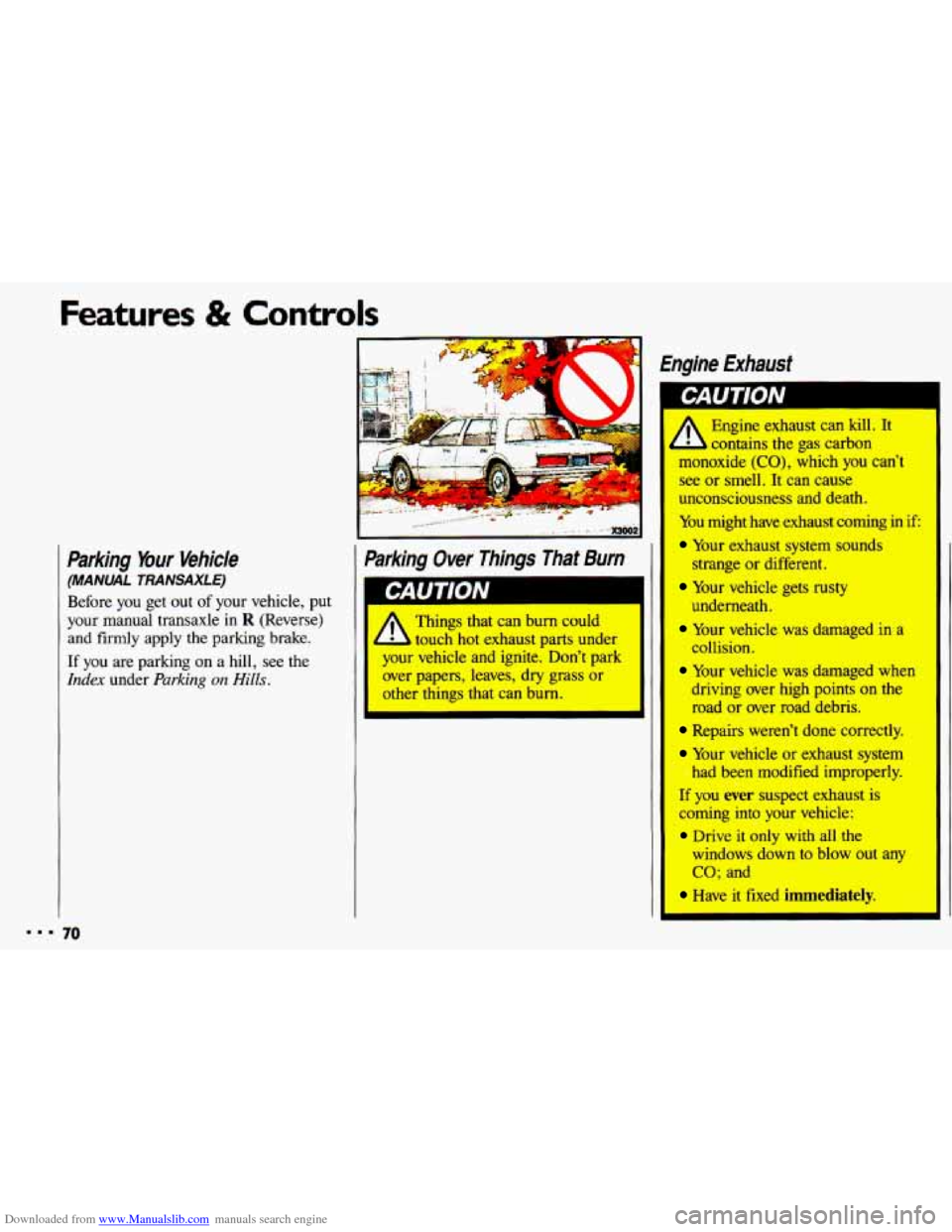
Downloaded from www.Manualslib.com manuals search engine Features & Controls
Parking Your Vehicle
(MANUAL TRANSAXLE)
Before you get out of your vehicle, put
your manual transaxle in
R (Reverse)
and firmly apply the parking brake.
If you are parking on a hill, see the
Index under Parking on Hills.
10
brking Over Things That Burn
I CAUTION
A
I
Things that can bum could
touch hot exhaust parts under‘
your vehicle and ignite. Don’t park
over papers, leaves, dry grass or
other things that can burn.
Engine Exhausf
I * - B contains the gas carbon
monoxide (CO), which you can’t
see or smell. It can cause
unconsciousness and death.
You might have exhaust coming in if
Your exhaust system sounds
strange or different.
Your vehicle gets rusty
underneath.
Your vehicle was damaged in a
collision.
Your vehicle was damaged when
driving over high points on the
road or over road debris.
Repairs weren’t done correctly.
Your vehicle or exhaust system
had been modified improperly.
If you ever suspect exhaust is
coming into your vehicle:
Drive it only with all the
Engine exhaust can
kill. It
windows down
to blow out any
CO; and
Have it fixed immediately.
=
Page 73 of 308
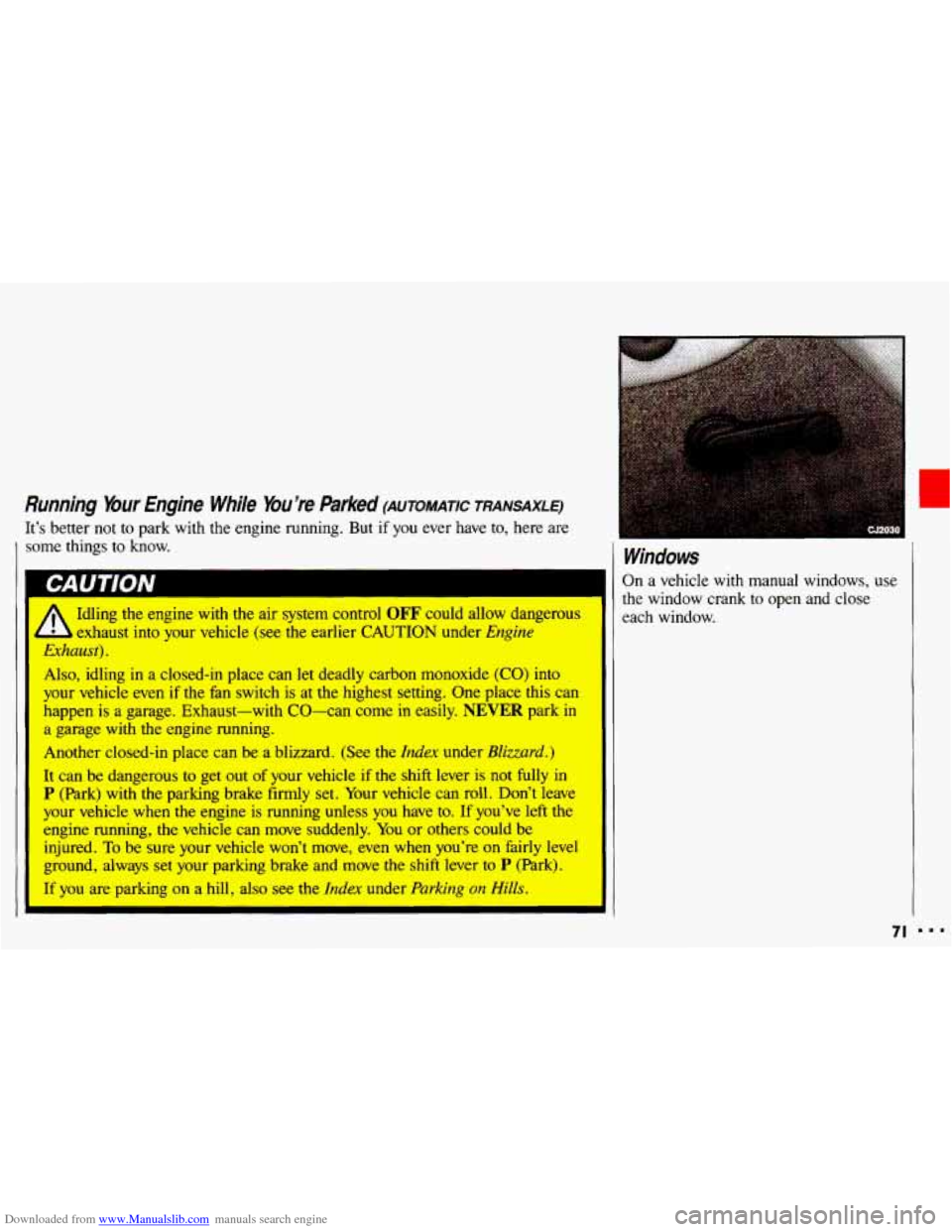
Downloaded from www.Manualslib.com manuals search engine Running Your Engine While You’re Parked (AuToMATIc TRANSAXLE)
It’s better not to park with the engine running. But if you ever have to, here are
some things to know.
I
Idling the engine with the air system control OFF could allow dangerous
1 exhaust into your vehicle (see the earlier CAUTION under Engine
Exhaust).
I
Also, idling in a closed-in place can let deadly carbon monoxide (CO) into
your vehicle even
if the fan switch is at the highest setting. One place this can
happen is a garage. Exhaust-with CO-can come
in easily. NEVER park in
a garage with the engine running.
Another closed-in place can be a blizzard. (See
the Index under Blizzard.)
It can be dangerous to get out of your vehicle if the shift lever is not fully in
P (Park) with the parking brake firmly set. Your vehicle can roll. Don’t leave
your vehicle when the engine is running unless you have
to. If you’ve left the
engine running, the vehicle can move suddenly. You or others could be
injured.
To be sure your vehicle won’t move, even when you’re on fairly level
ground, always set your parking brake and move the shift lever
to P (Park).
If
you are parking on a hill, also see the Index under Parking on Hills.
Windows
3n a vehicle with manual windows, use
:he window crank to open and close
:ach window.
71 ...